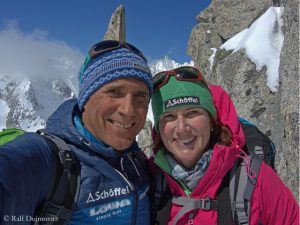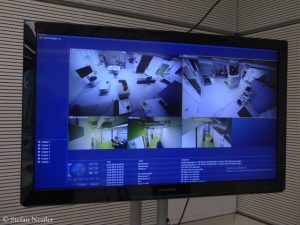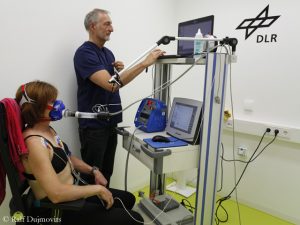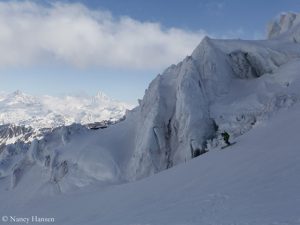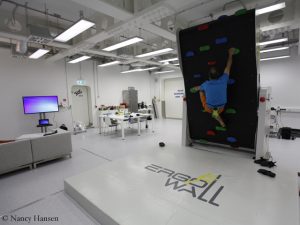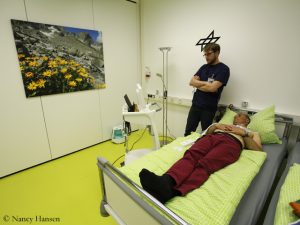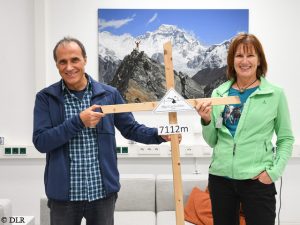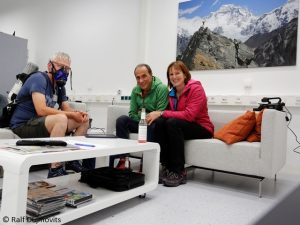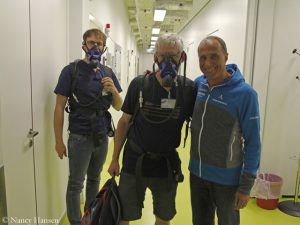Dujmovits: “We are in good hands here”
The doors have closed behind Ralf Dujmovits and Nancy Hansen. The so far only German climber who has scaled all 14 eight-thousanders and his Canadian partner moved in a 110-square-meter hypoxia chamber of the German Aerospace Center (DLR) in Cologne on Tuesday. As reported, the two mountaineers are participating in a study conducted by DLR in cooperation with the University of Texas to investigate whether extreme hypoxia can also have a positive side effect for human beings. US researchers from Texas found in two experiments with mice that heart muscle cells devided when the animals were exposed for two weeks to oxygen deficiency corresponding to conditions at 7,000 m. In mice which had previously been triggered myocardial infarctions, cardiac function improved after two weeks of hypoxia.
Medical control around the clock
Ralf and Nancy, both healthy, are the subjects of the pilot study. They are to stay in the hypoxia chamber for about a month. In the first few weeks, acclimatization as on a Himalayan expedition is simulated. The oxygen percentage in the air will be gradually lowered and temporarily increased only twice in between – as if the two climbers would descend again to breathe thicker air. The last two weeks, the 56-year-old German and the 49-year-old Canadian are to spend in a simulated height of 7,000 meters. The experiment can be stopped at any time in case serious problems arise. A DLR research team monitors Dujmovits’ and Hansen’s state of health around the clock. The daily schedule includes heart and lung function checks, blood and urine tests, fitness checks and so-called “cognition tests”, which check the reaction and perception of the subjects.
Yesterday, I visited the two climbers in their new “home”. That was possible on Wednesday for the last time without breathing mask. After more than half hour in a simulated altitude of about 3,700 meters, I felt a little bit dizzy. I preferred to do the interview with Ralf subsequently in thick air, by phone.
Ralf, you can not get out, there is no daylight, and the oxygen is lowered. That does not sound like a holiday apartment.
No, it isn’t a holiday apartment. But we have adjusted ourselves to it over a long period of time. We took it that way. We prepared ourselves mentally for almost nine months. Now we are here and actually feel quite well.
How does the prospect feel of being locked up for weeks and not being able to move to fresh air? That must be almost like torture for a climber.
Not even like that. I have the great privilege that I was allowed to be outside a lot. I do not see a big problem with being inside for five weeks now. We have been asked this frequently. But neither Nancy nor I are very worried that we can not handle it. We both can be very focused on special things. We have agreed to it and accept it as it is.
How did you prepare for this experiment? Have you filled up as much fresh air and nature as possible?
We were in Valais for a week. We spent the final two nights on the Gnifetti Hut at 3,700 meters, followed by a night in the winter room of the Capanna Margherita on the Signalkuppe at 4,550 meters. So to say, we had pure nature for us. We were completely alone on the Capanna Margherita for 24 hours. We got up at 6.30 a.m. to enjoy the beautiful sunrise. Then we skied down to the Monte Rosa Hut through best powder snow. We really filled up, had a great time and, of course, a bit of pre-acclimatization too.
What motivates you to participate in this study?
Nancy had in her family environment some cases of heart attacks that ended either deadly or in very difficult recovery. Therefore, motivation for her is really to be able to bring something forward in the field of research. It’s similar with me. My interest in medicine has always been there and will continue. Being able to be possibly part of a new treatment for heart attack patients is a great story.
Maybe it’s also an additional motivation that this “seven-thousander”, which you want to scale, is still unclimbed.
Of course, it’s a bit of a first ascent. (laughs) But it’s not so much this first-time act that motivates us, but rather the support to get a step further in heart attack research.
Are you also worried, be it mental or physical, when you consider the weeks in the hypoxia chamber?
There was a big unknown we both had a hard time with. It is not so easy to convert the percentage of oxygen in the air to (virtual) altitude. We have to rely on what Jens and Uli (Prof. Jens Tank and Dr. Ulrich Limper from DLR, the heads of the study) had predicted. But here we also have the opportunity to see how the air is composed by means of sensors installed in all rooms. From my feeling, that fits very well. Therefore, the trust that we must have in the team, is absolutely justified. We feel we are really in good hands here.
You are now the first complete day in the hypoxia chamber, at a quasi-altitude of about 3,700 meters. Does it feel different than on a mountain?
Of course, it’s different because the hardness factors such as strong sunlight, wind, cold, storm or snow fall are missing. So, of course, it’s much easier. But the thin air feels as we know it from high altitude – although the height is simulated by reducing the oxygen content. Normally, this percentage is always the same, no matter how high you are. (The hypoxia is caused by the lower pressure with which the oxygen is pressed into the lungs.) Here nitrogen is pumped into the rooms and thus the oxygen percentage decreases.
Do you think that you will learn something about yourself in the next few weeks?
I have already learned a lot. There are many, many little things. For example, we trained on the mobile climbing wall yesterday. It was specially set up for us here because we wanted to stay fit while climbing. We immediately noticed that not the lack of power in the arms or fingers will be the limiting factor, but the stamina in the thin air. We underestimated that. If we climb the overhanging part of the wall here, we’ll probably never get to the point where we run out of energy, but we’ll be at the limit in terms of endurance.
Does it help you to get through the whole thing as a couple?
That definitely makes it a lot easier. Yesterday at dinner I briefly imagined what it would be like if I were sitting here alone, maybe watching the news and then going to bed by myself. That would be terrible. You do not have anyone to talk to about what happened during the day. Being able to do this together with your partner is really great. We have a lot to laugh about. But we had also the first difficult moments during the night. Nancy suffered from headache, I had a slight pressure in my head. You talk about it, and then it’s a bit easier again.
Is it a bit like sitting in a base camp in bad weather and not being able to avoid each other?
You can really compare it. I remember for example 2009, when we were stuck in Lhotse Base Camp for three weeks in extremely bad weather and could only switch between our personal tent and the mess tent. It’s not much different here. However, we actually have more space to move, because the rooms here are very spacious. In addition, we have a lot of tasks to do during the day.
What do you expect, how will you come out of this experiment? As a physical wreck?
That’s the big unknown. We originally planned to go on expedition afterwards and use this extremely good acclimatization. However, cause we have no idea whether we are still fit enough to climb an interesting mountain, we have limited our plans to the Alps. There are e.g. on the south side of Mont Blanc so many high-altitude destinations. If we’re still fit enough, we’d rather go there instead of buying a permit, having to pay a liaison officer in advance, and then maybe having to say: We’re too weak, it’s just not possible.
But it’s also possible that you will be just lazily lying in the sun?
It’s possible too. After the time here in the chamber, the trade fair “Outdoor” will take place in Friedrichshafen. After that we’ll have a bit of time left without obligations. Maybe then we will be lying in the sun.



